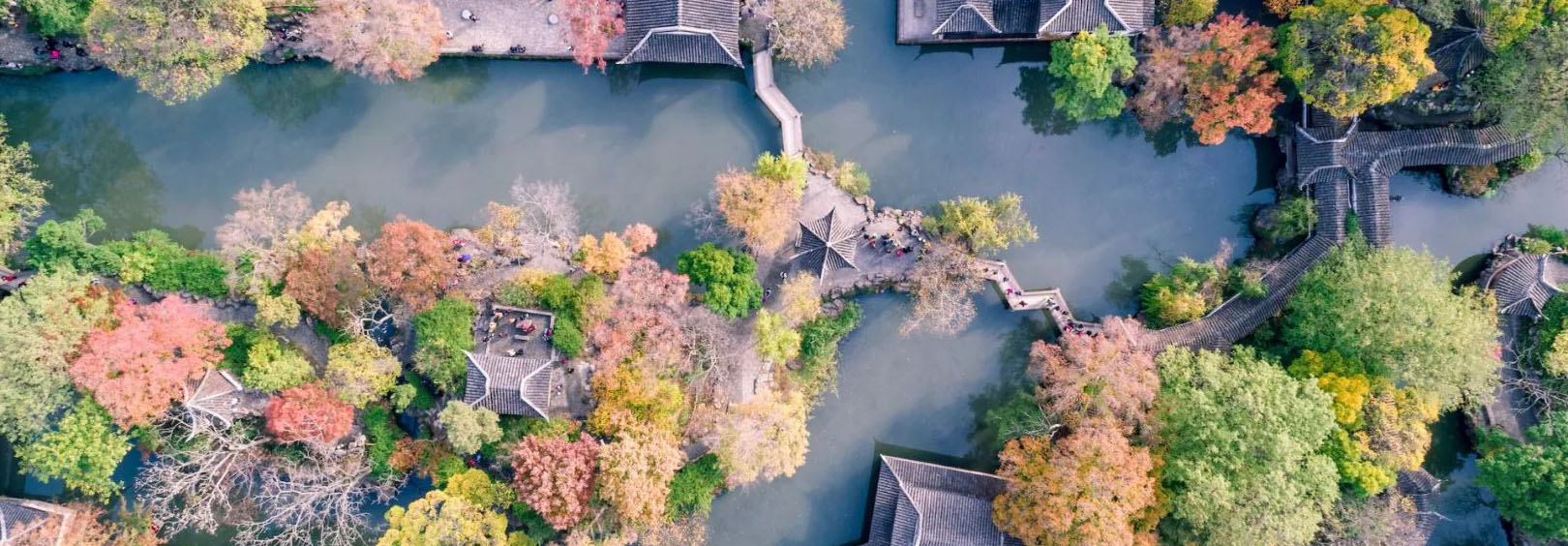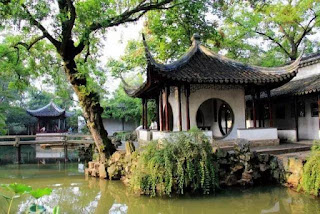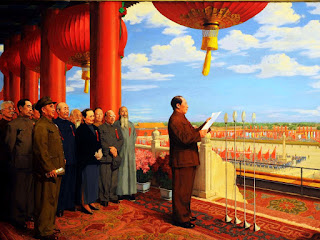Humble Administrator’s Garden
Humble Administrator's Garden, a representative of Jiangnan gardens, is the largest and most famous garden in Suzhou. It's also one of four classic gardens (others are Beijing Summer Palace, Chengde Summer Resort, and Suzhou Lingering Garden ) in China. The entire garden is composed of three parts: east, central, and west parts, in which the middle part is the essence.
 |
| Humble Administrator's Garden |
Basics of the Humble Administrator’s Garden
Name: 拙政园 in Chinese and Humble Administrator's Garden in English
 |
| Humble Administrator's Garden |
Area: 5.6 hectares (13.8 acres)
Age: Built in the 1510s with a history of more than 500 years
Entrance Tickets: 70 RMB (Jan., Feb., Mar., Jun., Nov., and Dec.); 80 RMB (Apr., May, Jul., Aug., Sep., and Oct.)
Opening Hours: 7:30 -17:30 (Mar.1st - Nov.15th); 7:30 - 17:00 (Nov.16 - Feb.)
Address: No.178, Northeast Street, Gusu District, Suzhou City, Jiangsu Province
The Time Needed: 2–3 hours
How Was the Humble Administrator’s Garden Built?
510 years ago, a middle-aged man named Wang Xianchen resigned from a government post and returned to his hometown Suzhou. He started to build the Humble Administrator’s Garden.
Born in an aristocratic family, Wang Xianchen was a prodigy at an early age. He was selected as a successful candidate
 |
| Corridor |
Wang Xianchen’s father proclaimed that he wouldn’t compromise his integrity to plead for his son. Therefore, Wang Xianchen’s career reached the lowest possible level. He continued to act on his discipline, which caused more hatred and jealousy. After several ups and downs, Wang Xianchen decided to resign.
At age 40, Wang Xianchen finally resigned and began to plan his garden. At the time, garden art was highly developed, and the garden building was very popular among scholars and ministers. Especially in Suzhou, abundant water resources, and exotic ornamental stones made the garden building easy. Therefore, Suzhou had many skilled gardening artisans. Wen Weiming, one of Wang Xianchen’s friends helped to design the Humble Administrator’s Garden.
In 1509, garden construction began. Unlike most of the existing gardens that collected strange flowers and stones, Wang Xianchen wanted his garden to be quiet and idyllic. Four elements, including rockery design, water layout, architecture, and plants, are particularly significant.
 |
| Lotus Pavilion |
The Humble Administrator’s Garden in the Ming dynasty integrated the last three elements. Rockery design was added in the Qing dynasty.
As the land Wang Xianchen chose already was already water-logged and the Suzhou was never short of rivers, the Humble Administrator’s Garden was themed with water to display a serene and reclusive atmosphere. The streams and ponds were built to flow; surrounding them were architectures and plants. In the center of the garden lies a spacious hall, which served as the living room. Fruits grew on the trees became a crucial source of income after Wang Xianchen’s resignation.
It’s said that the garden’s construction lasted for 16 years. Upon its completion, Wang Xianchen chose Zhuo Zheng (Humbler Administrator) as the garden’s name. On the one hand, he assimilated himself with the Western Jin Dynasty scholar Pan Yue, who referred to himself as a humble person who administrated and lived on building homes, planting trees, watering gardens, and selling vegetables. Wang Xianchen resorted to self-mockery to impose self-confinement.
Change Hands Multiple Times
Several years after the completion, Wang Xianchen died. His son made the garden as the wager and lost it to the Xu
 |
| Begonia Spring Dock |
Then, Wang Yongning, general Wu Sangui’s son-in-law, took residence here. He dug ditches, built buildings, and made carvings, significantly transforming the garden. With Wu Sangui’s defeat, Wang Yongning’s garden was once again confiscated.
In 1738, Wang Yongning’s garden was divided into Shuyuan Garden and Fuyuan Garden. Jiang Qi, the proprietor of the Fuyuan Garden managed to restore the old looks of the Humble Administrator’s Garden. Unfortunately, the garden became desolate with his death. By far, the original garden built by Wang Xianchen was divided into eastern, middle, and western gardens.
 |
| Mountain Viewing Tower |
In 1860, King Zhong Li Xiucheng captured Suzhou; he integrated the three parts into one garden and expanded it, forming a big residential garden. He changed the initial Mengyin Tower into the Mountain in View Tower and made it his office. The tower is quite unique. It stands on the pond surrounded by water, leaving one end to connect the outside. Besides, the passage to the upper floor is hidden outside. Therefore, it’s hard to attack the tower, which makes it perfect for King Zhong’s office.
After the Taiping Rebellion (1851 - 1864) being repressed, Qing minister Li Hongzhang divided the Humble Administrator’s Garden into two parts. The eastern garden was taken by the Xu family, the central part was controlled by officer Xing Yuan, and the eastern garden became desolate.
In 1871, Zhang Zhiwan took over the middle part of the garden and restored its original appearance. The western garden was sold to a local tycoon named Zhang Lvqian, who changed the name to Buyuan Garden. After founding the new China, the garden finally became a state-owned property that opens for the visit.
Highlights of the Humble Administrator’s Garden
Architectural Beauty
 |
| Orchid and Snow Hall |
Suzhou gardens are compact, exquisite, comfortable, and practical. To invite more sunlight and frequent airflow, the buildings have raise cornices and meticulously pierced windows. Unlike the traditional Siheyuan, Suzhou gardens have various buildings to fit the surrounding scenery better, including pavilions, towers, corridors, and kiosks. The exterior eaves are diversified. There is a round ridge resting hill, single-eave resting hill, octagonal double - floor building, etc. In terms of inner eaves decoration, it's more about keeping harmony with the environment. Pines, bamboos, plums, Qin, chess, calligraphy works, and paintings are mainly used for decorative purposes.
Eastern Garden
 |
| Heavenly Spring Pavilion |
Orchid and Snow Hall (Lanxue Tang): It’s the primary hall in the Eastern Garden. In the center of the hall is a screen decorated with A Panorama of Humble Administrator's Garden on the south side and Bamboo Painting on the north side.
Lotus Pavilion (Furong Xie): It’s a building half-built on the bank and half on water, making it a perfect spot for enjoying fish. In the pond before the pavilion plants lotuses. It’s a great pleasure to sit in the pavilion and enjoy the lotus swing along with the wind.
Heavenly Spring Pavilion (Tianquan Ting): It’s an octagonal building with a double-hipped roof. The eaves are so raised like a phoenix ready to fly.
Middle Garden
 |
| Boat-like Structure |
Boat-like Structure (Xiang Zhou): Its name implies its shape and uniqueness. Looking afar, it’s like a boat coming from lotuses. The entire building is composed of a small bridge, a platform, pavilions, attics, and towers. They are well-arranged to offer a fantastic view.
Mountain Viewing Tower (Jianshan Lou): It’s a two-floor building with a top like a dragon’s head, a body like a dragon’s body, a hole like a dragon’s mouth, a curved bridge like a dragon’s beard, and a cloud wall like dragon’s tail.
Place to Listen to Pine Wind (Song Feng Shui Ge): It has several lodgepole pines on one side. With the wind blowing upon, pines give a powerful sound.
Western Garden
18 Camellias Hall (Shiba Mantuoluohua Guan): It’s the primary building of the Western Garden Divided into the south and north parts,
 |
| Mandarin Duck |
the 18 Camellias Hall is shaped like a mandarin duck. The northern hall is for summer, and the southern hall is for winter. The owner used to entertain people, enjoy operas, and meet guests here. Each corner has a small chamber that allows performers to change. Besides, the hall is decorated with white and blue glass windows in rhombic shape. It’s a pleasure to enjoy the sunshine coming through the windows.
Waveform Corridor (Boxing Lang): It’s a corridor connecting the Middle and Western Gardens. It’s like a jade belt flowing upon the lake.
Poetic Beauty
The design of the garden emphasized creating a big world within a small space. The garden puts on a different show with
 |
| Zhuiyun Peak |
Zhuiyun Peak (Eastern Garden): Located outside the Lanxue Tang, Zhuiyun Peak is to block people’s sight, which tends to keep the unlucky outside and hide the inner wealth.
Begonia Spring Dock (Middle Garden): It's a small independent courtyard on the east side of Linglong Pavilion. It has two Begonia trees, one elm tree, and a cluster of bamboos. The white walls act as a canvas that is painted with trees, plants, and cobblestone paths.
Rain Listening Pavilion (Central Garden): It has a small pond in front and several banana trees in it. Just imagine sitting in the pavilion and creating poems and paintings while the raindrops on the banana leaves.
Spatial Beauty
Water and bridges are the souls of the Suzhou gardens.
 |
| Wu Zhu You Ju |
Using the water system as the medium, the Humble Administrator's Garden aligns everything perfectly, including the flowers, trees, hills, stones, and buildings.
Secluded Pavilion of Firmiana Simplex and Bamboo (Wu Zhu You Ju in Central Garden): It lies against the corridor and faces a pond with Firmiana Simplex and Bamboos standing on sides. Unlike other pavilions, the pavilion has four circular doors, from which you can enjoy views of four seasons.
Hall of Distant Fragrance (Yuanxiang Tang in Central Garden): It has four french windows and no pillar inside, which offers a wonderful view of the outside.
Cultural Beauty
 |
| Kun Opera |
Aside from being a place of scenery, the Humble Administrator's Garden is a space for living. The pavilions, terraces, buildings, porches were where the owners of the garden enjoyed tea, listened to music, chanted, and painted. Through the garden design, the Su-style culture is presented. Either it's about naming the buildings, creating couplets on the columns, or inscribing stones, everything is meticulously arranged to fit the surrounding landscapes. Today, people can enjoy tea while listening to the Qun opera in the garden.
Beauty of Vitality
The Humble Administrator's Garden is dominated by lush greenness.
 |
| Hall of Distant Fragrance |
It has ever-green bamboos, pines, plum trees, banana trees, and lotus.
Dwelling Upon Return to the Countryside (Gui Yuan Tian Ju in Eastern Garden): It has hills, lotus ponds, pine forests, and bamboo docks.
Bonsai Garden (Penjing Yuan in Western Garden): It collects over 1600 kinds of stubs and azalea bonsai.
Summer Hall (Xiari Tang): It has a large field of lotus in front.
Hall of Distant Fragrance: It’s surrounded by a peony garden in the east, a lotus pond in the north, and osmanthus forest in the west, and yellow stone rockeries in the south.



Comments
Post a Comment